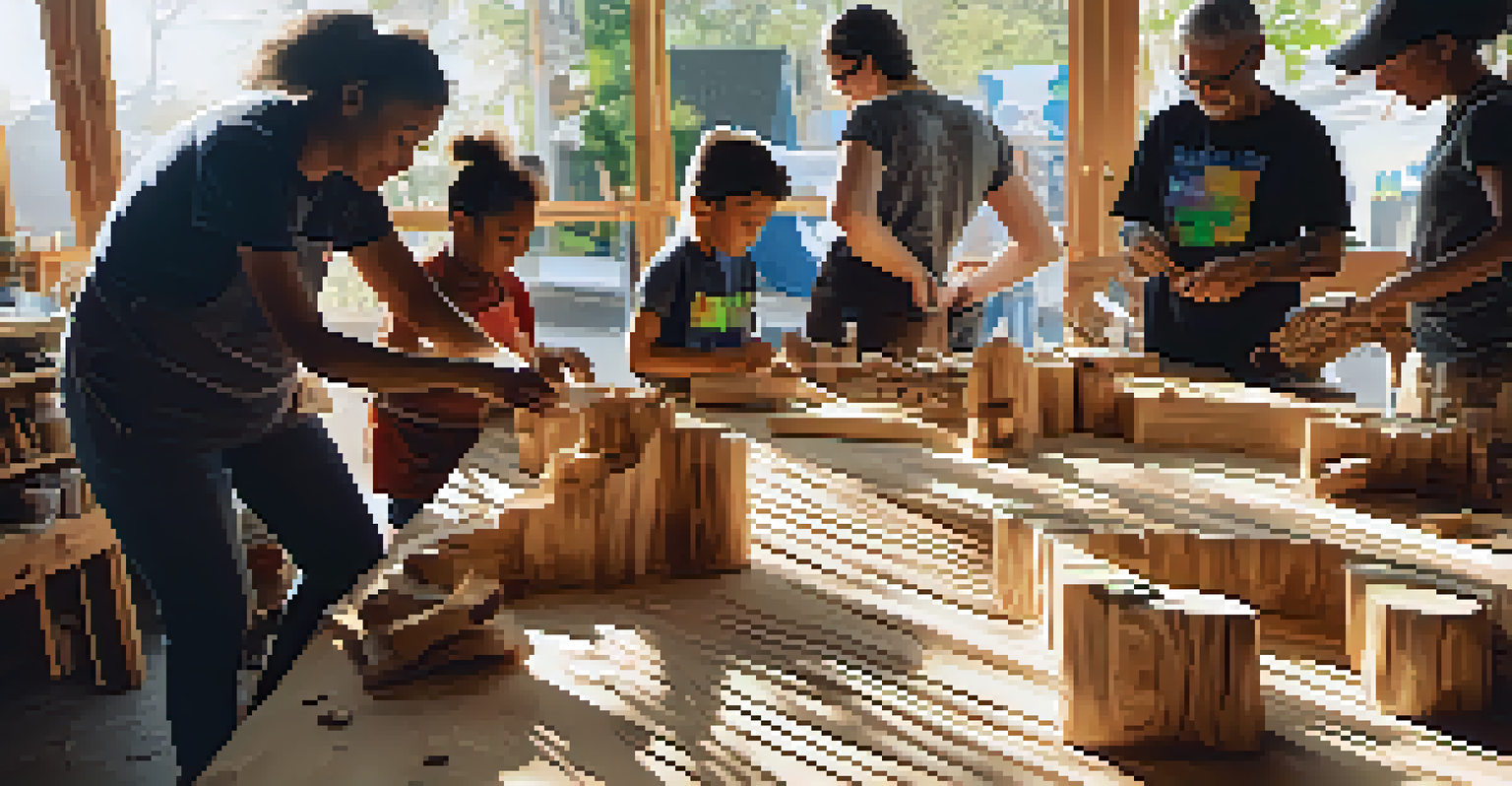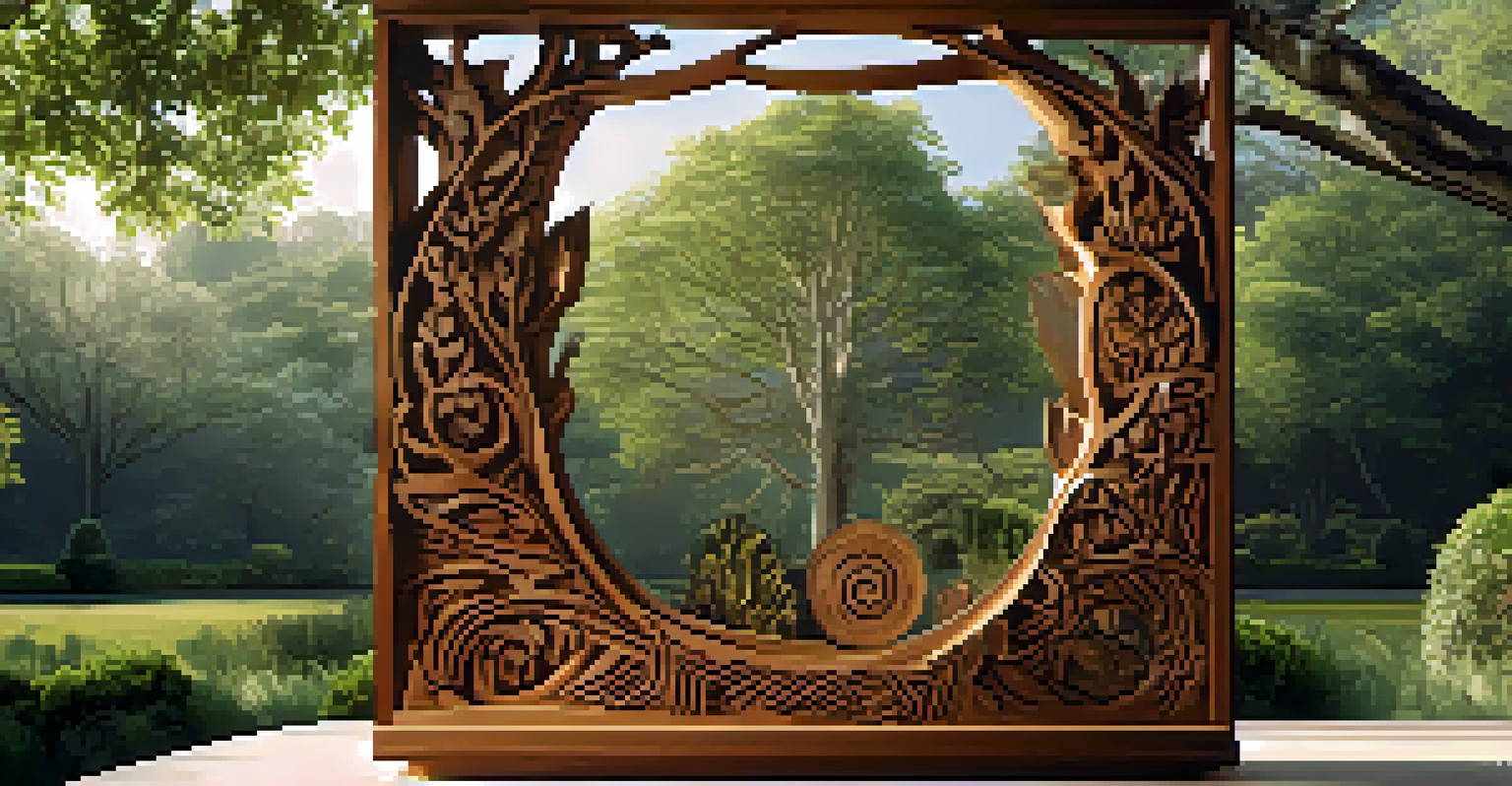Balancing Art and Environment: Carving with Purpose

The Intersection of Art and Environmental Stewardship
In today's world, the relationship between art and nature is more crucial than ever. Artists are increasingly finding ways to express their creativity while honoring the environment. This intersection not only fosters appreciation for nature but also encourages sustainable practices in art-making.
The best way to predict the future is to create it.
For instance, wood carvers are now selecting their materials with care, opting for sustainably sourced timber. This shift reflects a growing awareness of the impact of deforestation and promotes a healthier ecosystem. By choosing responsibly harvested wood, artists can contribute to conservation efforts without sacrificing their artistic vision.
Moreover, this approach leads to a deeper connection between the artist and their medium. When a wood carver understands the story behind their material, it enriches their work and resonates with audiences. Ultimately, balancing artistic expression with environmental responsibility can create a powerful narrative that inspires change.
Sustainable Sourcing: What It Means for Carvers
Sustainable sourcing refers to obtaining materials in a way that does not deplete resources or harm ecosystems. For wood carvers, this means looking for timber that is certified by organizations like the Forest Stewardship Council (FSC). Such certifications ensure that the wood comes from responsibly managed forests.

Not only does this practice help preserve forests, but it also supports local communities that rely on these resources. By choosing sustainable options, artists can boost local economies while fostering a sense of community. This creates a win-win situation for both the artist and the environment.
Art Embraces Environmental Care
Artists are increasingly integrating sustainable practices into their work, fostering a deeper connection with nature.
Additionally, using reclaimed wood is another fantastic way to practice sustainability. By repurposing old furniture or buildings, carvers can breathe new life into materials that might otherwise end up in landfills. This not only reduces waste but also adds unique character to each piece of art.
The Role of Creativity in Environmental Awareness
Art has a unique power to convey messages and evoke emotions, making it an effective tool for raising environmental awareness. Wood carvers can use their craft to highlight the beauty of nature and the importance of preserving it. By creating pieces that reflect environmental themes, artists can inspire viewers to take action.
Art is not a thing; it is a way.
For example, a sculpture that showcases the intricate details of a tree can remind people of the vital role trees play in our ecosystem. When art resonates with audiences, it can spark conversations about sustainability and encourage them to reconsider their own consumption habits. This ripple effect can lead to a more environmentally conscious society.
Moreover, collaborations between artists and environmental organizations can amplify this message. Joint projects can engage communities in creative ways, fostering a collective sense of stewardship. Together, artists and activists can create a powerful movement that advocates for the preservation of our planet.
Techniques for Eco-Friendly Wood Carving
Eco-friendly wood carving techniques focus on minimizing waste and using sustainable tools. Carvers can opt for hand tools instead of electric ones to reduce energy consumption and promote slower, more mindful craftsmanship. This approach not only benefits the environment but also enhances the artistic process.
Another technique involves using non-toxic finishes and adhesives. Traditional wood finishes can contain harmful chemicals that may release toxins into the environment. By choosing natural alternatives, artists can ensure that their work is safe for both themselves and the planet.
Sustainable Sourcing Benefits All
Choosing sustainably sourced materials not only preserves ecosystems but also supports local communities and economies.
Additionally, carvers can adopt a mindset of resourcefulness by utilizing every part of the wood they work with. Scraps can be saved for smaller projects or used in mixed-media art, reducing waste and encouraging creativity. This not only honors the material but also reflects a commitment to sustainability.
Community Engagement Through Wood Carving
Engaging with the community is vital for artists looking to promote environmental consciousness. Wood carving workshops can serve as platforms for education, where participants learn about sustainable practices while honing their skills. This hands-on approach fosters a sense of connection to both the craft and the environment.
Collaborative projects, such as community sculptures made from reclaimed wood, can further strengthen this bond. These initiatives not only beautify public spaces but also bring people together for a common purpose. They offer a tangible way for communities to express their values and commitment to sustainability.
Furthermore, involving local schools in wood carving projects can instill a sense of responsibility in younger generations. By introducing students to eco-friendly practices, artists can inspire future creators to prioritize the environment in their own work. This nurturing of creativity and awareness is essential for a sustainable future.
The Impact of Digital Tools on Wood Carving
In the modern age, digital tools play a significant role in the art of wood carving. Software programs allow artists to design intricate patterns and visualize their creations before they even touch the wood. This not only streamlines the process but also minimizes waste, as artists can plan more effectively.
Additionally, laser-cutting technology has emerged as a game changer for wood carvers. This method allows for precision and efficiency, enabling artists to create complex designs that may have been challenging with traditional techniques. However, it's essential to balance the use of technology with sustainable practices, ensuring that the materials used are eco-friendly.
Digital Tools Enhance Eco-Carving
The use of digital tools in wood carving streamlines the creative process while promoting environmentally responsible practices.
Ultimately, the integration of digital tools in wood carving can enhance creativity while promoting environmental responsibility. By merging traditional craftsmanship with modern technology, artists can explore new avenues for expression while still adhering to sustainable principles.
The Future of Wood Carving and Sustainability
As we look to the future, the relationship between wood carving and sustainability is likely to evolve. With increasing awareness of climate change, artists will continue to seek innovative ways to express their commitment to the environment. This could lead to the development of new materials and techniques that prioritize sustainability.
For instance, bio-based materials derived from agricultural waste may become mainstream in the wood carving community. These alternatives not only reduce dependence on traditional timber but also contribute to a circular economy. As artists embrace these innovations, the possibilities for creative expression will expand.

Moreover, the ongoing dialogue about environmental issues will inspire future generations of wood carvers. By embedding sustainability into their artistic practice, these artists can create work that not only captivates but also advocates for the planet. In this way, wood carving can become a powerful force for positive change.